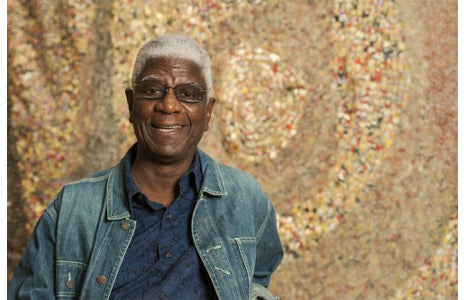Art is rubbish!
El Anatsui
Making art from recycled materials will produce a fun and engaging lesson to open imaginations and boosts historical and geographical knowledge.
El Anatsui, pronounced ah-nah-ch-wee, was born in Ghana in 1944. He lives and works in Nigeria and often uses everyday materials that have been thrown away.
As well as beer bottle tops, he uses many other types of found items including, tin cans, driftwood, nails and railway sleepers. Some of his installations are large enough to cover the outside of buildings.
El Anatsui’s work is not easy to define - are they sculptures or paintings? His work also raises questions about ethnic identity because it combines traditional African techniques and imagery with Abstract Western art.
Pupils will:
• Learn about El Anatsui’s work.
• Be able to recognise the materials used.
• Design a work of art using recycled materials.
• Find out about the different methods artists use to express themselves.
Where to begin
As pupils look at El Anatsui’s work, ask them to describe what they see. Look carefully at the way each piece is created and discuss the materials used. Encourage children to consider why El Anatsui uses recycled things. When they saw El Anatsui’s work, did they realise what they were made from? What recycled items could pupils use in their project?
Look at El Anatsui’s technique of sewing together materials to make a sculpture/painting. Encourage pupils to consider producing work inspired by El Anatsui and think about how they will join items together to form a painting or sculpture.
At the craft stage, look through the materials you have available. Fabrics and paper can be cut, glued and sewn together to form the artwork.
What El Anatsui says about his work
‘I saw the bottle caps as relating to the history of Africa in the sense that when the earliest group of Europeans came to trade, they brought along rum originally from the West Indies that then went to Europe and finally to Africa as three legs of the triangular trip…The drink caps that I use are not made in Europe; they are all made in Nigeria, but they symbolize bringing together the histories of these two continents’.
Some of El Anatsui’s works have been compared to Kente cloth the traditional cloth of Ghana, and also with Western mosaics and tapestries.
What materials does El Anatsui use to create art?
El Anatsui uses many found items in his work these range from used milk tins, railway sleepers, driftwood, iron nails and printing plates.
By using recycled African materials, he highlights the many places in the world where people have no choice but to use what is available to them.
Here is an opportunity to discuss the methods El Anatsui uses and encourage children to think about using recycled materials.
Design a recycled work of art
• Pupils can review El Anatsui’s use of recycled materials and reflect on what they represent.
• Encourage children to think about what they would like to create and what materials they will use.
• Ask pupils to reflect on what their work might represent.
• If the class is to hold an art exhibition, they could consider each other’s work and discuss the use of colour and imagery.
• Do they find techniques used by other individuals useful and perhaps something they would consider using in the future?
• Pupils may reflect on the benefits of examining, reproducing and imitating other artists to improve individual creative skills.
How to extend the lesson
• Explore how other artists use recycled materials.
• Look at how artists from different cultures recycle everyday materials.
• El Anatsui uses found materials that include sawdust, tin cans, driftwood and nails. What found items can pupils use to create art?
• Are there items we throw away that we could reuse in other ways?
• El Anatsui’s work has been compared with that of Gustav Klimt, the Austrian artist, can pupils see similarities?
Useful questions to ask the pupils
• What do you know about El Anatsui and his work?
• What do you think about the way El Anatsui explores the themes of consumption and our environment?
• Do you think that the items we throw away can be transformed into works of beauty?
• What materials will you use to create your work of art?
• Look at Ink Splash II. Are the blue and yellow colours paint or woven metal? Do the colours look like ink splashes? Does the blue at the bottom of the canvas look like it’s running onto the gallery floor?

The Charlie Crow Art Kit
The Charlie Crow Art Kit includes over 1 kilogram of useful fabric swatches and can be used to create many art and craft activities.
The kits cost £10 each with free standard delivery included. You can receive a FREE Art Kit with every school order over £50.










